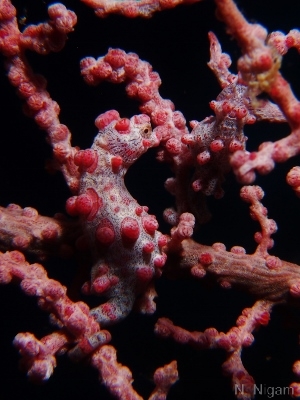Wakatobi: The World’s Best Reefs
Jul 02
by Nirupam Nigam
Deep in the heart of Indonesia, some of the best diving in the world can be found in Southeast Sulawesi. The reefs of this region are renowned for their remarkable biodiversity and healthy corals. A diver can find anything from looming sea fans and schools of batfish to pygmy seahorses and sea snakes. Perhaps the most popular dive resort in the region is the famed Wakatobi Dive Resort.
Getting to the resort is no small feat. Upon arrival in Bali, divers must spend a night on the island and then fly two and a half hours to the island of Tomia. From there it is a short twenty minute boat ride to one of the most remote locations on the globe. However, all this travel is beyond worth it.

Maranggo Airstrip
Almost as famous as the diving, the service at Wakatobi is some of the best in the world. You literally do not have to lift a finger. The staff is happy to help with anything from setting up dive equipment to finding anemone fish under the jetty. And after you are done diving, three gourmet meals a day are served by some of the best chefs in Indonesia. The service is not a service for tip; it is a service of Karma – a philosophy that remains strong with Indonesians. At the end of the trip, you feel as though you have made quite a few friends.

Sunset
The reefs at Wakatobi are some of the only reefs in the world that are getting better every year. The resort works with local villages to create sustainable fish populations and sustainable reefs – a strategy that has been working wonders. In fact, the house reef has been rated one of the world’s best shore dives and the number one house reef in the world!

5-6ft Barracuda at the House Reef
Divers have the option to dive as many dives as they want at the house reef from 6am to 10 pm every day. The resort even offers a water taxi service to reach farther areas of the house reef. There are also has several “Waka-boats” that take divers to various areas of Wakatobi National Park to dive three times a day. These dives are guided by some of the most knowledgeable dive guides in Indonesia. If you are looking for a certain species of marine life, chances are that they will find it for you.

Pygmy Seahorse found by Dive Guide
Wakatobi’s reputation for housing many macro gems is well deserved. Underwater photographers will not be at a loss for subjects. In fact, there are often so many subjects that it is hard to pick one to photograph. The famed pygmy seahorse is common at Wakatobi as well as many species of shrimp, gobies, anemonefish, squat lobsters, nudibranchs, coral polyps, ribbon eels and much more! Although Wakatobi can be a little lacking in big fish (though they are observed from time to time), the reef fish of Wakatobi are so plentiful and colorful that the reefs appear almost unnatural.

Periclimenes sarasvati in an Anemone
Although it had not been brought into the spotlight, the wide angle opportunities for photographers at Wakatobi rival the macro opportunities. Soft and hard corals are diverse and abundant. Huge cabbage and table corals inhabit the shallows while towering seafans and sponges inhabit the deep. Colorful crinoids dot the reefscape and curious turtles travel the house reef. Some of the guides are even happy to model in your photos!

Wakatobi’s name comes from the combination of the names of five of the main islands in the region. Likewise the Wakatobi diving is a combination of many factors – from friendly service to healthy reefs to an eco-friendly philosophy. These factors have created a dive experience and a resort that is second to none.
Thank you Bluewater Photo for hosting the SoCal Shootout, in which I won the trip.





Related Articles
Popular Articles